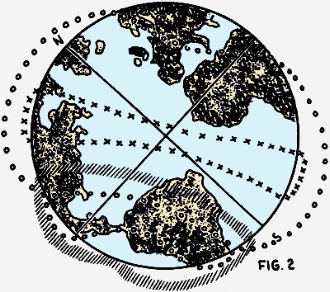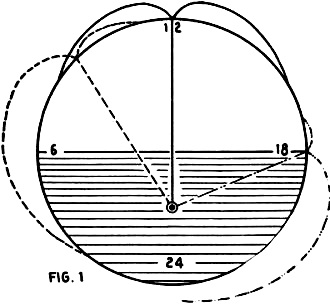The Propagation of Short Waves
|
|
"Short waves," with their ability to support long distance communications under certain conditions, became a phenomenon in the late 1920s, and a market developed for converting commercial broadcast receivers to short wave receivers. Magazines at the time were full of advertisements for the devices. The particulars of short waves and the way they propagated in the upper atmosphere were not yet well understood early on. In fact, the government considered transmission frequencies above 1.5 MHz (≤200 meters) so useless that they assigned those bands to amateur radio operators. The presence of an electrically conductive layer, known as the ionosphere, was not verified until 1927 by Edward Appleton. Hams quickly investigated, experimented, and successfully exploited the long distance radio communications possibilities so successfully that the government quickly re-claimed most of the bands. They were rewarded by being prohibited from engaging in transmissions for the duration of America's involvement in World War II. Much has been learned about the ionosphere since 1931 (the publication date of this article), but what is printed here is still largely valid. For instance and very importantly, the F2 layer (not identified or named at the time of this article) which is highest layer of the ionosphere, is maximum where the sun is directly overhead (see numbers on this spacew.com F2 map). See part 2 in the February / March 1932 edition of Short Wave Craft. The Propagation of Short Waves The author describes his new theory of the effect of cosmic energy and change of season on the transmission and reception of short waves. The solar radiation of electrons in their effect on short waves is discussed. By Robert Meyer (Hamburg, Germany) In the last few years, many radio listeners have tried to change over to the reception of short waves. Much success has been attained but the interest in general waned very soon; because in the short-wave field there are peculiar propagation conditions which, so far, have not been understood in their basic principle. Even the set owner who is well up in the working conditions on the well-known broadcast wavebands, is confronted by puzzles in the case of the bands which have been investigated but little. It is a well-known fact that the working conditions or ranges of all the bands change once in the period of a day; but that this change is considerably modified by the season of the year. This observation led the writer to formulate the idea that the emission of the short-wave transmitter is something secondary; the influencing or modulation of a cosmic energy being probable. With this assumption, it becomes clear that even a nearby transmitter must remain inaudible, unless a flow of this cosmic energy is present between the sender and the receiver. Fig. 1 - Daily range-displacement of short waves. Fig. 3 - Short wave lines of conduction in winter. Now it is natural that we should, in view of the cosmic dependence of the earth on the sun, take into account the solar radiation of electrons, to explain the formation of lines of conductivity for short-wave transmitters. The solar electrons strike the earth and are partially reflected; after reflection, they must describe a curve which is determined by their own velocity and the attraction of the earth. Fundamentally, therefore, the reflected electrons must describe a path, through the atmosphere, from the point of rebound to the "night side" of the of the earth (the side away from the sun). The curve must always have the same form, since the two effective components (velocity and attraction) do not change their relation. If, nevertheless, the distance traversed by the electrons varies according to the time of day, then an important factor must have remained hitherto unconsidered. It has been recognized, since Newton, that the reciprocal action of two bodies in space does not take place in the true centers of the bodies, but lies eccentrically according to the respective strengths of the bodies. From the reconstruction of many observed zones of reception, I now found the ideal or specific center of terrestrial attraction displaced about half the earth's radius or 1,980 miles, toward the north magnetic pole. The position of this center of attraction may be seen in Fig. 1; and from this diagram there also becomes clear its significance for the determination of reception zones. The reflection curves of the solar electrons are represented for three different hours of the day. With vertically falling sunbeams, at 12 (noon), there is formed a symmetrical "umbrella" of conductive lines; for the imaginary axis of the reflection path passes through both the center of the earth and also through the theoretical center of attraction. The range formed at about 10 o'clock is unsymmetrical; the branch pointing to the south is shortened, and the effective path to the north is lengthened. Still greater is the distortion in the case of the reflection. umbrella formed in the evening twilight. There the northerly-directed branch is so expanded that it does not touch the earth again; therefore this line of propagation is useless for practical communication. In both cases the influence of the ideal center of terrestrial attraction is plainly recognizable. Practical experience is accordingly confirmed and explained by the writer's theory. According to this assumption, there hangs over the earth on the day side, a multiple "umbrella," which contains, besides the lines shown, all the intermediate stages. At the same time there is a possibility of communication between any two places on the surface of the earth, which are touched by the same line of conductivity. The lines themselves are given continuous excitation from solar electrons. In the course of a day, in view of the rotation of the earth, each point on the surface of the earth describes a fixed path in this "umbrella" structure, and finds operating conditions periodically changing. Besides the daily revolution, the earth annually completes a circuit about the sun; whereby there is caused a constantly changing angular inclination of the earth's axis to the sun. This second motion of the earth in the cosmically-located network of conductive lines (which are therefore fixed in space) is the cause of the changes in range which occur during annual periods, as may be seen from Figs. 2 and 3. The ranges indicated in Fig. 1 may again be recognized over the earth, which is shown in its summer and winter positions. Although both illustrations show the same time position of 18 o'clock (i.e., 6 P. M.) Greenwich time, the continents differ greatly in their positions to the network of conductive lines. For instance, the course of radio waves from Europe to South America is considerably longer in winter than in summer, and the operating conditions are worse. - Wissen und Fortschritt.
Posted May 25, 2023 |
|



